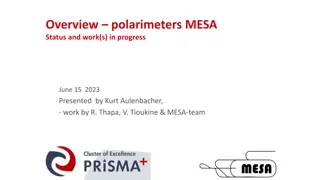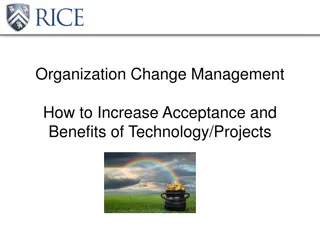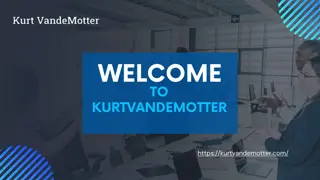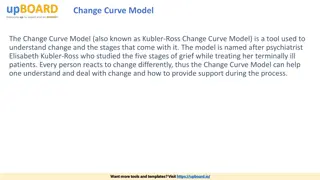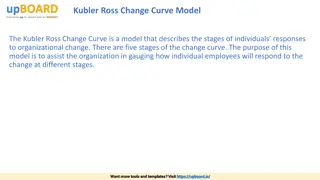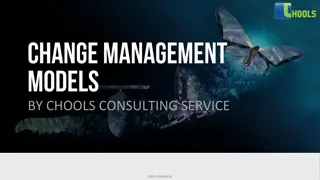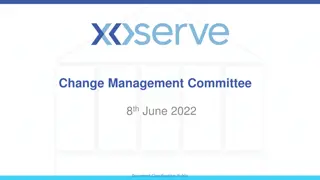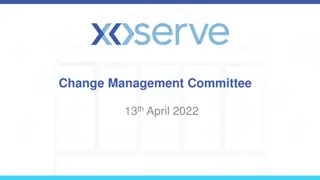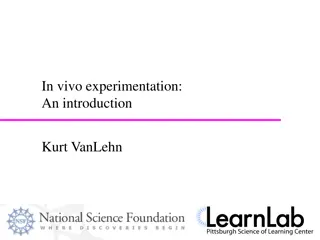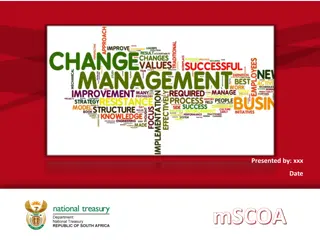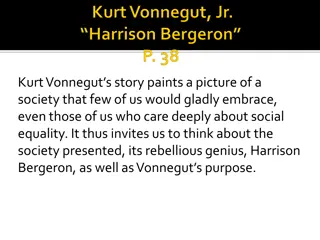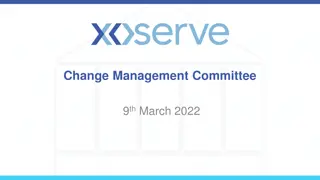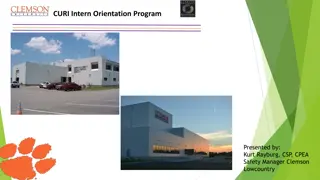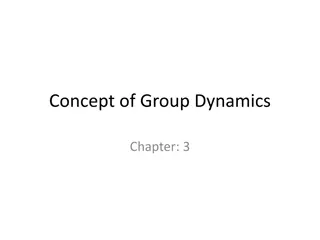Understanding Kurt Lewin's Change Management Model
Explore Kurt Lewin's Change Management Model, its key components, implementation strategies, and the factors that contribute to the success or failure of change initiatives. Learn about Kurt Lewin's background, Lewin's Golden Rules for Change, common barriers to change, and the essential factors that help organizations achieve successful change. Discover practical steps for managing change, handling resistance, and communicating effectively throughout the change process.
Download Presentation

Please find below an Image/Link to download the presentation.
The content on the website is provided AS IS for your information and personal use only. It may not be sold, licensed, or shared on other websites without obtaining consent from the author. Download presentation by click this link. If you encounter any issues during the download, it is possible that the publisher has removed the file from their server.
E N D
Presentation Transcript
Kurt Lewins Change Management Model Jeremy Trowsdale Human Resources 6/2020
DISCUSSION TOPICS Change Initiative Stats Success & Failure Factors Lewin s Change Management Model Lewin s Golden Rules for Change The Three Stage Model The Importance of Each Stage Practical Steps for Using the Model Criticisms of the Model Additional Guidance for Managing Change Change Communication Awareness Resistance to Change
Why Change Fails Top barriers in major change initiatives: Competing resources Functional boundaries Lack of change skills Middle management Long IT lead times Communication Employee opposition (resistance) Initiative fatigue Unrealistic timetables Source: PricewaterhouseCoopers 48% 44% 42% 38% 35% 34% 33% 32% 31%
Making Change Succeed Factors that helped the most successful organizations achieve their goals Good communication Strong mandate by senior management Setting intermediate goals and deadlines Having an adaptive plan Having access to adequate resources Demonstrating urgency of change Setting performance measures Delivering early, tangible results (quick wins) Involving customers and suppliers early Benchmarking competitors Source: PricewaterhouseCoopers 100% 95% 95% 91% 86% 86% 81% 76% 62% 62%
Who was Kurt Lewin? Kurt Lewin was born in Poland in 1890 Modern pioneer in social, organizational, and applied psychology Professor at University of Berlin & a number of U.S. universities before becoming director of the Center for Group Dynamics at the Massachusetts Institute of Technology (MIT) Theories formulated in 1940s and still in use today Referred to as the Guru of Organizational Change theory
Lewins Golden Rules for Change Kurt Lewin s change theory identified several golden rules on how change should beimplemented: 1. Change should only be implemented for good reason. 2. Change is most effective when done gradually. 3. Change should be planned and not sporadic or sudden. 4. Strive to include individuals who may be affected by the change as much as possible in planning for the change. Lewin: "Motivation for change must be generated before change can occur.
Kurt Lewins Three stage model: Approaches to Managing Organizational Change
Three Stage Model One of the cornerstone models for understanding organizational change was developed by Lewin back in the 1940s, and is still effective in the modern era Creating a sense a change is needed His model, known as Unfreeze Change Refreeze, refers to the three-stage process of change he describes. Moving towards a new and desired behavior He explained organizational change using the analogy of changing the shape of a block of ice. Setting this behavior as the new normal
Three Stage Model The pandemic has provided impetus for unfreezing and for being agile.
Lewins Block of Ice Metaphor Let s say you have a cube of ice but you d like to have a cone of ice. To transform the cube shape you must: 1. unfreeze or melt the ice 2. change the mold to a cone shape and 3. refreeze the water into the new, desired shape It s a simple three-stage process that allows you to easily diagnose which stage you are in.
Stage 1: Unfreeze The Unfreeze stage involves preparing the organization to accept that change is necessary and then creating the motivation to change However, motivation is intrinsic to each individual. I cannot motivate you. You cannot motivate me. But I can create the conditions, messages, and environment that may influence you to want to change. The key: Develop a compelling message showing why the existing way of doing things cannot continue. Easiest to frame when you can point to something tangible (declining revenue, poor financial results, concerning employee or student satisfaction surveys, etc.) Example: COVID-19 Rowan moved from business as usual to totally remote in 30 days! Sometimes the unfreeze must be quick!
Stage 1: Unfreeze Keep in mind that the first part of the change process is usually the most difficult and stressful expect challenges! In this stage, ask yourself: Why did we do certain things the way that we did? (challenge the status quo). What to expect: many people will feel uncomfortable and off balance; strong reactions from some people, but .the unfreeze process is necessary! Note:The pandemic has and will reduce much of the pushback during this time of change Requires strong support from Management Bottom line: With uncertainty already existing and the need for change evident, it s important for the organization to re-examine its core and build a strong motivation to seek out a new equilibrium. Without this motivation, it s difficult to obtain the buy-in and participation necessary to effect meaningful change. What are some positive ways we have or will have to frame the need for change at Rowan during and after the COVID-19 pandemic?
Force Field Analysis Lewin s change model suggested a methodology for analyzing change he called the Force Field Analysis. Essentially, this involved three steps: Analyzethe restraining or driving forces that will affect the transition to the future state restraining forces include the reactions from those who see change as unnecessary , constituting a threat , or are feeling uncertainty or fear during the pandemic. Assessdriving or restraining forces which ones are critical to involve or address? Take stepsto increase the critical driving forces + decrease the critical restraining forces. Example How can we use this process to leapfrog during this difficult time?
Stage 2: Change The Change stage has a focus on the solution new ways of working. It begins with new approaches to problems. With new approaches comes new learning and it takes place here: Goals are established Smaller, acceptable changes that reinforce and support change are instituted Management structures are developed Open, two-way communication (dialogue) is maintained This stage requires active stakeholder participation (especially w/ those impacted by the change). Usually, the transition from unfreeze to change does not happen overnight: people take time to embrace the new direction and participate proactively in the change.
Common Stages in a Change Curve Another helpful change model, the Change Curve, focuses on the specific issue of personal transitions in a changing environment and is useful for understanding the stages individuals may go through during a change initiative. Example: Shock Oh no, not another form. Denial Maybe if I don t look at my emails Frustration I don t have 25 hours in my day. Depression Well, I have no choice. I have to get this done. Experiment How can I get this done? What is the best way? Decision I am accountable for this and will get this done. It is best for the students/patients/staff. Integration Woo-hoo! I succeeded and this feels great! Where do you think most of your team members are in the curve at this time?
Recognizing the Individual Change Response Denial Commitment P r o d u c t i v i t y What you See What you Hear What you see What you hear Future Orientation Silence Indifference How can I contribute Initiative It will never happen Disbelief Let s get on with it Self-efficiency It won t affect me Avoidance Confidence What you see What you see What you Hear Energy What you hear Anger It won t work Risk taking Optimism Complaining It used to be Tentativeness I ve got an idea Glorifying the past The data is flawed.. Impatience Let s try Activity without focus Skepticism What if . Resistance Unwillingness to participate Exploration Adapted from Kubler -Ross
Another Change Consideration: WIIFM? What s in it for me? In order to accept the change and contribute to making it successful, people need to understand how it will benefit them. Not everyone will fall in line just because the change is necessary and will benefit the organization. This is a common assumption and a pitfall that should be avoided. Unfortunately, some people will genuinely be harmed by change, particularly those who benefit strongly from the status quo. Others may take a long time to recognize the benefits that change brings. It s important to foresee and manage these situations. How do you assess who will be negatively affected the most by the necessary changes in a post COVID-19 Rowan? What can you do for those groups of people?
Sound Reasoning & Inclusion With Decision-Making When you are making the actual changes, internal acceptance may be lacking if you don t: Base your decisions on a rigorous and systematic process (hunches yielding a good enough outcome just won t cut it) Using CDC data, NJ Directives, and other approved resources will drastically reduce the second-guessing of decisions made at this time Involve all who are concerned by the change It's not so much that we're afraid of change or so in love with the old ways, but it's that place in between that we fear . . . It's like being between trapezes. It's Linus when his blanket is in the dryer. There's nothing to hold on to. Marilyn Ferguson
What to Expect from Change Initiatives No matter how positive, promising or proactive the change is, expect a sense of loss from some people No matter how competent and committed stakeholders are, expect a sense of confusion at times No matter how loyal employees are, expect some initial skepticism and an increase in me focus Modern case study for Lewin s Model: Gas Prices and the American auto industry in the 21st century, go to this YouTube video (about 2 minutes long): https://www.youtube.com/watch?v=uHR8gw6derg
Stage 3: Refreeze The Refreeze stage needs to help people and the organization internalize or institutionalize the changes. Measure success Are the new measures being followed consistently? Are they incorporated into everyday business? Offer training to those struggling with the change; accountability if necessary Don t tweak a new process too soon give it time to allow for a more accurate measure of the success of it (although that may be difficult during fluid times!) New attitudes, values, and behaviors are established as the new status quo. Staff willbegin to feel confident and comfortable in this new world until .... The next cycle of change comes around, that is! And it will as we continue to react. With change initiatives, we want to be proactive but in this difficult time how we plan will depend on some forces that are outside our control.
The Importance of the Refreeze Stage You might ask, Why create a sense of stability when we live in an ever-changing world? Even though change is a constant, this refreezing stage is still very important. Without it, employees get caught in a transition trap where they aren't sure how things should be done, so nothing ever gets done to full capacity. There isn t even a brief settling in time So, in the absence of a new frozen state, it becomes very difficult to tackle the next change initiative effectively. How do you go about convincing people that something needs changing if you haven't allowed the most recent changes to sink in? Change will be perceived as change for change's sake, and the motivation required to implement new changes simply won't be there. Important Note: As part of the refreezing process, make sure that you celebrate the success of the change this helps people to find closure, thanks them for enduring a painful time, and helps them believe that future change will be successful. It s a critical step not to skip!
Why are all of the stages so important? Let s look at this scenario to explain why all three steps are so important. Let s imagine you skip the unfreezing phase and go straight to the change phase. What will happen? Most likely, the change will meet resistance. Why? Prevailing forces such as old values will begin to increase to counter the change. This leads to misunderstandings and a lack of trust (consider the Force Field Analysis model to visualize this scenario the restraining forces can wreak havoc on the change initiative)! One challenge we will have to deal with is that although the pandemic unfroze our environment, many people still expect to return to the status quo.
Practical Steps for Using the Model Stage 1 Unfreeze: 1.Determine what needs to change Examine/Survey the organization to understand the current state Understand why change has to take place 2. Ensure there is strong support from senior management Use Stakeholder Analysis/Management to identify and win the support of key people within the organization Frame the issue as one of organization-wide importance 3. Create the need for change Create a compelling message about why change has to occur Use your vision and strategy as supporting evidence Communicate the vision in terms of the change required 4. Manage and understand the doubts and concerns Remain open to employee concerns and address them in terms of the need to change
Practical Steps for Using the Model Stage 2 Change: 1. Communicate often Do so throughout the planning and implementation of the changes Describe the benefits Explain specifically how the changes will affect everyone/Prepare everyone for what is coming 2. Dispel rumors Answer questions openly and honestly Deal with problems quickly Relate the need for change back to operational necessities 3. Empower action Provide lots of opportunity for employee involvement Have line managers provide day-to-day direction The Key: Change is fluid but it s important for employees to understand where Rowan is in the process and why we have done it!
Practical Steps for Using the Model Stage 3 Refreeze: 1. Anchor the changes into the culture Identify what supports the change Identify barriers to sustaining change 2. Develop ways to sustain the change Ensure leadership support Create a reward system if applicable Establish feedback systems Adapt the organizational structure as necessary 3. Provide support and training Keep everyone informed and supported 4. Celebrate success! Example: For Rowan, the first Refreeze may be bringing students back on campus. Keep in mind: This stage may not fully occur until we are past COVID-19
Criticisms of Lewins Change Model The main criticism of Lewin s change model is that it is quaint and simple for the modern era of constant and rapid change. The critics would ask: Isn t the Unfreeze Change Refreeze model too simplistic for today s rapidly changing world? The Refreeze stage, in particular, implies a great deal of time is spent establishing the new status quo. Does that work in our fast paced society? Lewin s model is sometimes criticized as being linear and without consideration for emotional life as people journey through change.
Criticisms Rebuttal The simplicity criticism may actually be the strength of the Lewin model. True, change management is complex, but simplifying it makes it easier for people to take action where uncertainty and complexity can paralyze any action altogether. As far as the question about the Refreeze stage taking too long goes Even in our current era of high speed and frequent change, we must have some degree of refreeze , otherwise we would get caught in a transition trap where people aren t sure how things should be done . As a result, we would not be able to perform at best capacity. Perhaps the biggest selling point for Lewin s model is that many change management models that followed have their roots in, and were inspired by his ideas.
Additional General Guidance for Managing Change
Additional General Guidance for Managing Change Ensure communication is presented with a united front; No we/they discussions or silos Empower action Win over your naysayers and utilize them as your content experts Reinforce and reward small steps in the process as major victories Make sure the changes are understood Remember to clarify what is not changing along with what is A key for Rowan at this time is managing our teams effectively in the remote environment (and will continue to be)
Additional General Guidance for Managing Change Take the time to understand how people are handling the changes Find out how people are doing along the way, not just at the end Provide opportunities for two way communicationand Venting (surveys, virtual Town Hall meetings, etc.) Don t just hear; Listen! Find supporting people Leverage the help of those who commit early
Framework for Change Communication (5 Communication Points) 1. Why is the change necessary? (rationale) Example: Rowan To survive budget reductions, provide for safety of students, faculty, and staff 2. What are we changing to? (Vision) 3. How and when do we intend to get there? (plan) 4. What is the personal impact? (What's in it for me? How does it affect everyone?) 5. Is help available to support the transitions? (resources)
Stress and Its Impact on Communication Mental noise in high-stress situations reduces the ability to process information by 80%, on average. Under stress, people have difficulty hearing, understanding and recalling information. Data shows that attention spans shrink to just 12 minutes or less, and people are only able to retain three main ideas. That means most of the 30-minute team conference calls, or the lengthy email updates explaining all the ins and outs of an organization s response to the virus, probably aren t breaking through the noise. Keep messages concise and clear and consider 3 concepts per communication Also using graphics, visual aids, analogies and personal anecdotes are usually effective because they can improve understanding by more than 50%.
Stress and Its Impact on Communication Example: Leaders of one university have been sending regular bulletins to staff with the latest updates on their response to the outbreak and implications for employees. In addition to using simple, straightforward language, the bulletins highlight in red text any changes from the prior communication, so recipients can easily scan them to see what s new. This simple formatting trick has greatly improved communication of the most critical information to staff. Additionally, an effort is made to limit each new communication to a maximum of three bulleted topics.
Communication with empathy The delivery method matters People need to know that you truly care about them before they start to care about what you know. It is critical during times of crisis to begin every communication with empathy. A simple opening such as I know the current situation has been very challenging, and we appreciate the toll it is taking on everyone helps diffuse anxiety and get people ready to listen to the facts that come next.
Resistance & Pushback It s important to understand that resistance is inevitable with any type of major change. Resistance can actually be a positive sign, evidence that people are hearing your message. It s a natural reaction to feeling a loss of control. People are no longer able to operate as they had expected, and that s uncomfortable. It s counterintuitive, but leaders should embrace resistance when it emerges, because only then can we respond wisely. Resistance follows highly predictable patterns. Think of the K bler-Ross stages of grief as a guide to how people process difficult change. After the initial shock, the steps are denial, anger, bargaining, depression and acceptance. The stages of grief above area part of the framework that makes up our learning to live with the ones we have lost. They are tools to help us frame and identify what we may be feeling. But they are not stops on a linear timeline in grief.
Resistance Example The early response in Italy to the partial pandemic restrictions issued at first in the north exemplifies the resistance phenomenon. After a presumed period of shock, denial and anger, many residents entered a period of bargaining, the you should make an exception for me because . . . stage. Many continued going about their daily lives. The virus continued to spread. We highlight this example not to cast blame but to illustrate that the reaction is normal and to be expected. Italy s next implementation of a nationwide restriction on movement and closure of nonessential businesses seems to have been more successful. Prime Minister Giuseppe Conte asked Italians to join him in an I Stay Home pledge. He urged citizens to make a common sacrifice to protect the elderly and avoid overwhelming the health system. His messages were full of empathy and clear facts, painting a picture of why this was necessary. Conte s approach helped his people move quickly through the resistance curve, accept the change and stay home.
Common Sources of Resistance Aptitude The individual is unable to (or at least it s very difficult to) make the change Attitude The individual doesn t want to make the change Threshold for Change The individual doesn t have the energy to make the change
Sources of Resistance: Aptitude Individual Abilities Low Tolerance for Change See change as more work Fear the unknown Fear inability to develop the new skills required Don t want to accept the death of the old ways (preservation of the past) Don t understand what it will take to be successful in the future state Have scars from prior changes
Managing Resistance: Aptitude Identify needed knowledge and skills Provide a training / development program Create opportunities to practice without consequences Reward demonstrations of new abilities Mentor and model desired behaviors and skills Monitor workloads to ensure they remain realistic
Sources of Resistance: Attitude Lack of Motivation Differing Assessments Don t see the need for change Change initiators usually have more information than stakeholders A compelling vision has not been presented Those affected may not see the Big Picture therefore the change does not make sense No positive consequences for changing Perceive costs greater than benefit
Managing Resistance: Attitude Ensure people understand why change is needed the business case for change Put the change into the context of the Big Picture ; possibly link it to other changes Convey a compelling vision for the future If possible, personalize benefits of the change Establish rewards, recognition, and performance objectives that support change objectives
Resistance Takeaways Leaders are trained to see resistance as bad when, in fact, it is the first sign that people are taking the change seriously. The right leadership reaction to resistance is to listen with empathy. Only then can we remind people why things need to change and begin to discuss how to make the change happen. In crisis situations, especially those as fluid as the coronavirus outbreak, many leaders are naturally drawn to a more protective, or fixed, mindset and behaviors. This can include defensiveness, denial, intransience in the face of changing facts on the ground and even blaming others. A learning mindset will serve us better. It involves adapting to what is needed and being willing to adjust a game plan as new facts emerge. Address the challenge with openness and optimism, conveying empathy for how people may feel.
Resistance Self-Reflection What resistance to change have you encountered in the past? How did you handle it? What worked well? What did not work well? Who can assist you?
48 5 Ways to lead in an era of constant change Ted Talks: Organizational Change Expert Jim Hemerling https://www.ted.com/talks/jim_hemerling_5_ways_to_lead_in_an_era_of_constant_change?langua ge=en#t-554202 Additional Information: If seeking some more information regarding organizational change, watch this 13 minute video; it provides some exceptional tips for organizational change in this era of constant change The greatest danger in times of turbulence is not the turbulence; it is to act with yesterday s logic. - Peter Drucker
Feedback & Implementation What are your thoughts on Lewin s Change Model? What concepts discussed today resonated the most with you? What changes will be the most challenging for Rowan following the COVID-19 pandemic?
References Daniel Lock Consulting Bayfront Health Mindtools Bain and Company Thank you for your attentiveness and your time!



